


“SIGHTSEEING”
周辺のみどころ
「オーベルジュ・ド・ぷれざんす 桜井」の周辺は見どころがたくさん。
「大和は国のまほろば」と記紀万葉に詠われた、 まさに日本の原風景ともいえる素晴らしい世界をぜひ堪能してください。
There is plenty to see around L’Auberge de Plaisance Sakurai. We invite you to enjoy one of the oldest landscapes in Japan, dating back to the ancient kingdom of Yamato, celebrated in the Kojiki and Nihon Shoki and the Manyoshu, Japan’s earliest historical texts and its earliest collection of poetry, as “one of the finest places in the land”.
桜井・天理エリア Sakurai and Tenri area
日本最古の道と言われる山の辺の道。一帯を歩けば、記紀万葉ゆかりの史跡が次々とお出迎え。古代のロマンにたっぷり浸ることができます。
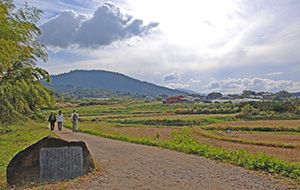
古代にタイムトリップできる散策道。天理市から桜井市にまたがるルートが人気です。
A hiking trail that will take you on a time trip to ancient Japan. The section between the cities of Tenri and Sakurai is especially popular.

鶏が自由にかっ歩する境内に、数多くの国宝や重要文化財が。日本最古の神社の一つです。
One of Japan’s oldest Shinto shrines. Many national treasures and important cultural properties can be seen in the grounds, where chickens roam freely.
-
 桧原神社Hibara-Jinja Shrine
桧原神社Hibara-Jinja Shrine大神神社の摂社で、三ツ鳥居と呼ばれる珍しい様式の鳥居があります。夕景もおすすめです。
A subsidiary shrine of the Omiwa Jinja shrine with a unique torii gate known as the Mittsu Torii. The shrine is particularly beautiful at sunset.
-
 景行天皇陵Tomb of Emperor Keiko
景行天皇陵Tomb of Emperor Keikoヤマトタケルの父と伝えられる第12代天皇の陵墓。古代史好きにはたまらないスポットです。
The tomb of Keiko, 12th emperor of Japan, said to be the father of the legendary hero Yamatotakeru. A must-see for lovers of ancient history.
-
 三輪山Miwa-san (Mt. Miwa)
三輪山Miwa-san (Mt. Miwa)記紀には神の鎮まる山とされ、麓の大神神社の御神体。そうめん発祥の地としても有名です。
Noted as a holy site in the Kojiki and Nihon Shoki, Japan’s earliest historical texts, Mt Miwa is venerated as a repository of the god enshrined at the Omiwa Shrine. The area is famous for somen noodles.
-
 大神神社O-miwa Shrine
大神神社O-miwa Shrineご祭神は国造りをした大物主大神(おおものぬしのおおかみ)。日本最古の神社と言われています。
The shrine is dedicated to Omononushi-no-Okami or Daikokuten, god of agriculture, and is said to be Japan’s oldest Shinto shrine.
-
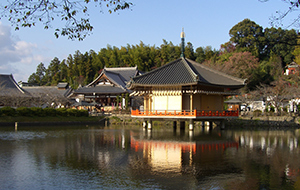 安倍文殊院Abe-monju-in Temple
安倍文殊院Abe-monju-in Temple「三人寄れば文殊の智恵」の格言が生まれたお寺。陰陽師 安倍晴明ゆかりの地でもあります。
The Japanese version of the saying “two heads are better than one” originated at this temple, which is also famous as the birthplace of the yin-yang master Abe no Seimei.
-
 聖林寺Shorin-ji Temple
聖林寺Shorin-ji Temple藤原鎌足の長男 定慧の創建。国宝の十一面観音立像は多くの文化人に感銘を与えています。
Founded by Jo’e, eldest son of Fujiwara no Kamatari, the temple houses an eleven-faced statue of Kannon, goddess of mercy, which is designated as a national treasure and has inspired many cultural figures.
-

 長谷寺Hase-dera Temple
長谷寺Hase-dera Temple牡丹の名所としても知られる、花の御寺。御寺に至る参道も賑やかで、草餅が名物。
Hase-dera is also called the “Temple of Flower”, and is famous for Chinese peonies. The lively approach to the temple is also popular, as well as the Japanese grass rice cake “Kusamochi”.
-
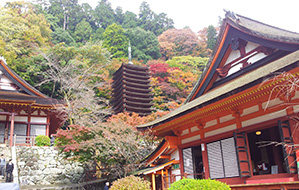
 談山神社Tanzan-Jinja Shrine
談山神社Tanzan-Jinja Shrine名称は、中臣鎌足と中大兄皇子が大化の改新の談合を行ったことに由来。秋の紅葉が見事です。
The name Tanzan (discussion shrine) comes from the meeting between Nakatomi (later Fujiwara) no Kamatari and Prince Naka no Oe (later Emperor Tenji) before the Taika Reforms of 645 AD. The grounds of the shrine are famous as a spot for viewing autumn leaves.
明日香・橿原エリア Asuka and Kashihara area
里山の風景が広がる「日本の心の故郷」ともいえるエリア。古墳や社寺、不思議な石造物などが点在し、レンタサイクルなどで散策も楽しめます。

稲渕の棚田は、いち押しの絶景スポット。昔懐かしい里山風景が広がっています。
The beautiful terraced rice fields of Inabuchi evoke Japan’s gentle, rural past.

幾何学的な溝が掘られた酒船石、巨大な亀石など、ミステリアスな石造物がたくさん。
Megalithic stones of mysterious purpose can be seen throughout the area. They include the Asuka Sakafune-ishi, with its geometric carvings, and a gigantic turtle-shaped stone.
-
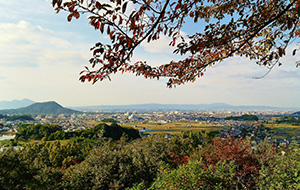 甘樫丘(国営飛鳥歴史公園)Amakashi no Oka (Amakashi Hill)
甘樫丘(国営飛鳥歴史公園)Amakashi no Oka (Amakashi Hill)ハイキングに適した緑豊かな丘陵。展望台からは明日香エリア一帯を見渡せます。
It is a green hill which is good for hiking. The observation deck at the top gives extensive views over the Asuka area.
-
 石舞台古墳Ishibutai Kofun (Ishibutai stone tomb)
石舞台古墳Ishibutai Kofun (Ishibutai stone tomb)説明する必要もないくらい有名な古墳。近くで見ればその存在感に圧倒されるはず。
One of the best-known ancient stone tombs in Japan, with an overwhelming presence.
-
 飛鳥寺Asuka-dera Temple
飛鳥寺Asuka-dera Temple蘇我馬子によって創建された日本最初の本格的な寺院。近隣に、蘇我入鹿の首塚もあります。
Asuka-dera Temple is one of the oldest full-scale Buddhist temples in Japan and was built by Soga no Umako, who implemented political reforms with Prince Shotoku. Nearby is the spot where the head of his grandson, Soga no Iruka, is buried.
-
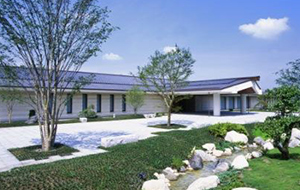 奈良県立万葉文化館Nara-kenritsu Man'yo Bunkakan (Nara Prefecture Complex of Man’yo Culture)
奈良県立万葉文化館Nara-kenritsu Man'yo Bunkakan (Nara Prefecture Complex of Man’yo Culture)万葉の時代の暮らしや文化を伝える総合施設。図書館、カフェ、ショップなどを併設。
An integrated information facility dedicated to the lifestyle and culture of the era when the Manyoshu, Japan’s oldest poetry anthology was compiled. Includes a library, café and shops.
-
 今井町民家群Imai-cho Minkagun (Imai-cho Historic District)
今井町民家群Imai-cho Minkagun (Imai-cho Historic District)一帯が江戸時代の町並みの雰囲気を残しており、時代劇などのロケ地にもなっています。
Imai-cho retains an atmosphere of the Edo era, and has been used as a film location for samurai dramas.
宇陀エリア Uda area
奈良県東部にある、奥深い自然と神社が残るエリア。宇陀松山地区はかつての城下町の風情を残しており、重要伝統的建造物群保存地区に選定されています。

古い街並みに加え、最近は古民家を改修したお洒落なお店も点在し、楽しく散策できます。
The old town of Uda Matsuyama is an exciting place to take walk. A number of traditional Japanese houses have been converted into smart boutiques.

大河ドラマでも取り上げられたほどの、見事な桜。毎年、数多くの花見客が訪れます。
The magnificent Matabei cherry trees attract many blossom viewers each spring.
-
 室生山上公園芸術の森Murou Art Forest
室生山上公園芸術の森Murou Art Forest室生寺の近くにある、アートをコンセプトにした公園。ユニークなオブジェの数々は必見です。
An art park situated near the Murou-ji Buddhist temple. The many unique artworks area must-see.
-
 室生寺Murou-ji Temple
室生寺Murou-ji Temple女人禁制の高野山に対し、女性の入山を許したので女人高野と呼ばれています。紅葉が有名です。
In contrast to Koya-san (Mt. Koya temple), the Murou-ji Buddhist temple allowed women to visit the surrounding mountains, and was known as Nyonin Koya (“women’s Koya”). It is also famous for autumn leaves.
吉野山エリア Yoshinoyama (Mt. Yoshino) area
吉野山は世界遺産に登録されており、由緒ある社寺や奥深い自然を徒歩で味わえます。桜、紅葉、雪景色など、季節に応じた表情も魅力です。
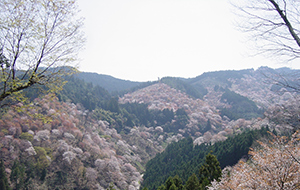
言わずと知れた桜の名所。麓から、下千本、中千本、上千本、奥千本と順に開花していきます。
Famous for its cherry blossom. In spring, the cherry blossom starts with the Shimo-senbon (lower 1,000 trees) at the foot of Mt. Yoshino, and gradually works its way up the mountain via the Naka-senbon (middle 1,000) and Kami-senbon (upper 1,000) to the Oku-senbon (inner 1,000).

修験道の開祖、役行者によって開かれた歴史あるお寺。吉野山のシンボル的な存在です。
A historic temple established by En no Gyoja, founder of Shugen-do, the religion practiced by the yamabushi ascetic hermits. The Kinpusen-ji Temple is the symbol of Mt. Yoshino.
-

 金峯神社Kinpu Shrine
金峯神社Kinpu Shrine大峯奥駈道を少し歩いた奥千本にある神社。近くに、源義経が身を潜めた隠れ塔もあります。
A shrine on the Omine-Okugakemichi trail, in the Oku-senbon area. Nearby is the tower where the 12th-century hero Minamoto no Yoshitsune hid from his enemies.
-
 吉水神社Yoshimizu-Jinja Shrine
吉水神社Yoshimizu-Jinja Shrine源義経、静御前が身を潜めたといわれる神社。境内からは吉野の千本桜が一望できます。
Known as the shrine where Minamoto no Yoshitsune and Shizuka Gozen hid. From the grounds, there is a view of the cherry trees of Yoshino.
-
 大峯奥駈道Omine-Okugakemichi trail
大峯奥駈道Omine-Okugakemichi trail吉野から熊野に至る修験の道。今も修行者が行き交い、神秘的な雰囲気を味わえます。
The Shugen-do trail from Yoshino to Kumano. Followers of Shugen-do still walk this trail, creating a mystical atmosphere.
